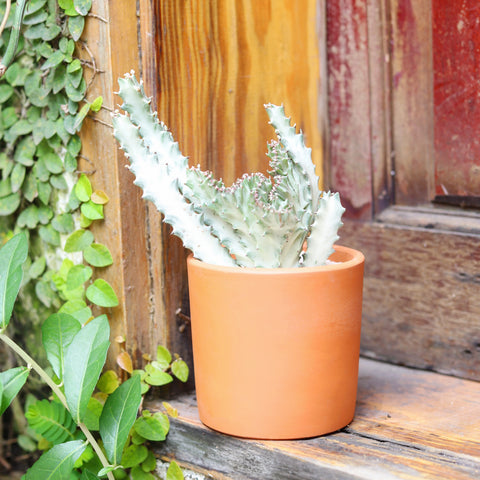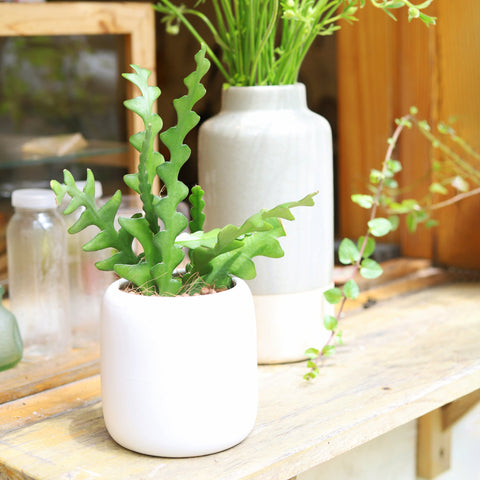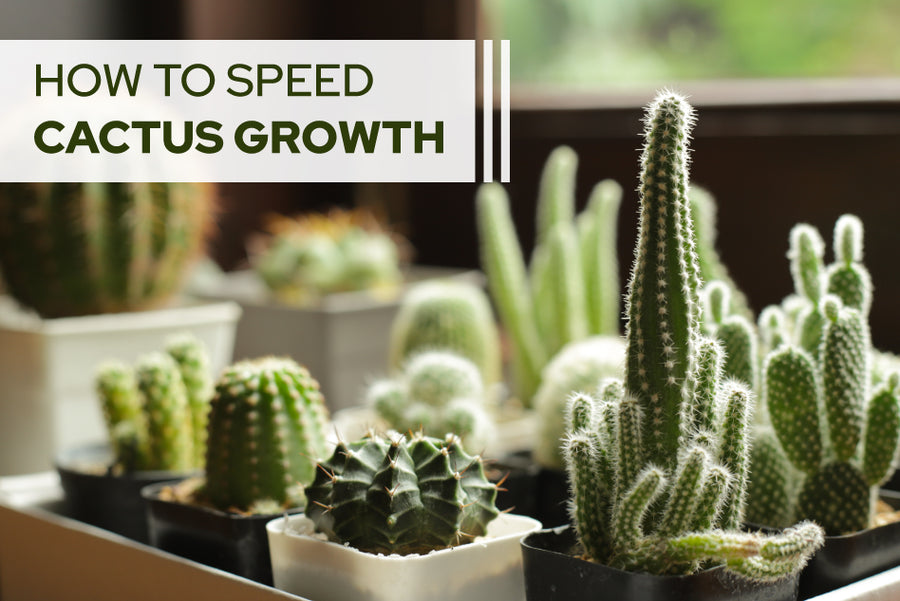Cacti, along with succulents, are some of the most slow-growing houseplants, and this nature is both a source of admiration and, at times, a point of frustration for plant lovers. The slow growth of cacti means that they require minimal attention and infrequent repotting. This slow-paced development aligns with the laid-back care routine that many appreciate, making cacti resilient and adaptable options for various living conditions. However, the flip side of this slow growth is that it can test the patience of plant enthusiasts, as it takes several years for cacti to show some significant increases in size. While their unhurried growth can be seen as a testament to their hardiness and ability to thrive in challenging environments, it also necessitates a patient approach for those looking to witness substantial changes in their cactus specimens over time.
The leisurely growth of cacti is actually a part of their nature to handle tough conditions. While it is impossible to turn cacti into fast-growing housplants, there are specific methods that can be employed to gently encourage and enhance their growth.
Why Are Cacti Slow-Growers?
The gradual growth of cacti can be ascribed to a combination of specialized adaptations that have evolved for them to thrive in arid and challenging environments. These survival strategies prioritize the plant's energy towards sustaining life rather than fostering rapid growth.
Firstly, water conservation is a critical survival trait for cacti in their native habitats. This strategy involves minimizing the number of stomata, which are tiny pores on leaf surfaces, to reduce water loss through transpiration. Stomata play a crucial role in the exchange of gases during photosynthesis, but they also result in water loss through transpiration. By reducing stomatal density, cacti decrease the surface area through which water can escape. While this adaptation conserves water, it can limit the rate at which gases, including carbon dioxide, are exchanged, slowing down the overall growth process.

Water conservation is a critical survival trait for cacti in their native habitats.
Additionally, many cacti species have thick, fleshy stems that serve as water storage organs. These stems allow cacti to store water during periods of abundance and utilize it during times of scarcity. While this adaptation is essential for surviving in arid conditions, the allocation of energy and resources to water storage may limit the resources available for rapid growth.
Moreover, the slow growth of cacti is associated with their energy-efficient metabolism. Cacti employ a modified form of photosynthesis known as Crassulacean Acid Metabolism (CAM). This unique process allows them to open their stomata at night, when temperatures are cooler and humidity is higher, minimizing water loss. While this adaptation is effective for water conservation, it results in slower overall growth compared to plants with alternative photosynthetic pathways.
Cacti Growth Rate
The growth rate of cacti can vary widely depending on factors such as species, environmental conditions, and care. Generally, cacti are known for their slow growth, and their annual growth can range from a few inches to no more than a foot in optimal conditions. Some cacti species may take several years to reach maturity, while others may take decades. The specific growth rates for all cacti species may differ, as they exhibit diverse growth habits. Certain species like Saguaro cactus (Carnegiea gigantea) are very slow growers, and their size may look unchanged for months or years. In contrast, some smaller cacti species, such as the Christmas cactus (Schlumbergera spp.) or certain Opuntia species, may have a somewhat a faster growth rate.
Despite their slow growth rate, cacti are known for their remarkable longevity. Many cacti have the potential to live for several decades, reaching impressive sizes. In the wild, some cacti can even survive longer under the right conditions. This ability to endure and thrive in harsh environments contributes to their impressive lifespan. Cacti employ various survival strategies, such as water storage in their thick stems, reduced leaf surface area to minimize water loss, and adaptations like the ability to go dormant during periods of extreme drought. These features enable them to withstand challenging conditions and thrive over extended periods. While their slow growth might mean they take time to reach maturity and substantial size, the enduring nature of cacti makes them fascinating and enduring additions to various landscapes.
How To Make Cacti Grow Faster
Give Them Plenty Of Bright Light
Most cacti naturally thrive in sun-drenched environments, being native to arid regions that receive ample sunlight. Cacti heavily depend on sunlight for photosynthesis, a vital process where they convert light energy into chemical energy. This energy fuels their growth, so to accelerate the growth of cacti, ensuring they receive an abundance of bright light is fundamental.
To ensure cacti receive adequate light exposure for faster growth, position them in a spot where they receive a minimum of six hours of direct sunlight daily. Optimal locations for this include south or west-facing windows, providing the required sunlight intensity. In cases where natural sunlight is limited, supplementing with grow lights becomes essential. You can use a full spectrum grow lamp that replicates the qualities of natural sunlight to promote cacti growth.

To ensure cacti receive adequate light exposure for faster growth, position them in a spot where they receive a minimum of six hours of direct sunlight daily.
For optimal lighting conditions, it's essential to prevent shading or obstruction. Make sure your cacti are not overshadowed by larger plants or hindered by furniture. Uninterrupted exposure to light is paramount for their development. Periodically rotating the pots helps expose all sides of the cactus evenly, preventing leaning or stretching towards the light source. Monitoring light intensity is crucial, as different cactus species may have varied requirements. Regularly assess the light the cacti receive and adjust their placement accordingly.
Observing their response, as particularly signs of etiolation (stretching towards light) can be an indicator of insufficient light. One important thing to take note is that if you introduce your cacti to direct sunlight after a long period of lower, indirect lighting, you should acclimate them gradually to prevent sunburn. Start with shorter durations and gradually increase exposure.
Maintain Warm, Stable Temperature
Cacti, naturally adapted to arid and desert environments, generally prefer temperatures ranging between 60 and 75°F. Maintaining the environment within this temperature range closely mimics their native habitat, contributing to the promotion of optimal growth. Cacti are resilient, but extreme temperature fluctuations can induce stress, so shielding them from abrupt drops or spikes in temperature is crucial. Temperature stability creates a more favorable environment for consistent growth.
Strategic placement in suitable indoor locations plays a crucial role in maintaining temperature stability. Ensure your cacti are positioned in areas with consistent temperatures, avoiding exposure to drafts or direct contact with heating or cooling sources. This precaution guarantees a stable and comfortable environment, facilitating healthy growth. Additionally, monitoring seasonal changes is essential. Being mindful of variations in temperature during different seasons allows for minor adjustments as needed. Providing a stable temperature throughout the year establishes an environment conducive to the steady and sustained growth of cacti.
Ensure Good Airflow
Facilitating good airflow is a fundamental element in promoting the healthy growth of cacti. Cacti, adapted to arid environments, are susceptible to fungal diseases in conditions of high humidity or poor air circulation. Ensuring good airflow helps prevent the development of fungal issues, fostering a healthier environment for cacti. Indoor cacti also thrive the best with excellent air circulation, mirroring their natural habitats. Replicating an airy environment helps them flourish.

Indoor cacti also thrive the best with excellent air circulation, mirroring their natural habitats.
As proper airflow assists in moisture evaporation, good airflow can reduce the risk of fungal infections and rotting. You should positioning cacti in areas with ample space around them is essential. Avoid clustering them closely with other plants, as this may impede air circulation. Adequate spacing enables air to move freely around the cacti, minimizing the risk of stagnant, humid pockets
For indoor cultivation, ensure that the room is well-ventilated. Open windows or use fans to promote air exchange, especially in regions with high humidity levels, as this helps create a drier microclimate around the cacti. When cultivating cacti outdoors, consider the natural wind patterns in your location and position them where they can benefit from gentle breezes. A bit of windy conditions would have an amazing effect in promoting airflow and reducing the risk of humidity-related issues.
Provide Well-Draining Soil and Pot
Along with proper lighting, the choice of soil mix plays a crucial role in nurturing and promoting the growth of your cacti. While cacti aren't particularly demanding about their soil, they thrive in porous and well-draining conditions. It is important to avoid waterlogged soil, and a gritty mix with inorganic components such as coarse sand, perlite, volcanic rock, and fine gravel is ideal for most cacti. You can also choose a high-quality soil mix tailored for succulents and cacti sold in gardening stores. As cacti like poor, sandy soil, avoid excessive use of compost and organic matter to prevent mold and pest issues.
Selecting an appropriate pot is equally crucial to facilitate effective drainage. Pots crafted from porous materials like concrete, terracotta, and ceramic, equipped with drainage holes, are optimal for cacti. Repot every couple of years when your plants show signs root bound to give the roots more room to grow.
Boost Root Health
Root health plays a crucial role in boosting cacti because the roots serve as the primary organs for water and nutrient absorption. By ensuring the roots are healthy and functioning optimally, the cactus can efficiently take up the essential elements it needs for growth. Proper root health also contributes to the plant's overall stability and support.
To promote root health, integrate soil aeration into your weekly care routine using a small shovel before watering. Gently manipulate the shovel to create small air pockets around the plant's roots. A well-aerated soil environment promotes oxygen availability to the roots. Oxygen is vital for various metabolic processes, including the conversion of nutrients into energy. Enhanced oxygen levels in the soil facilitate the efficient functioning of the root system, ultimately supporting faster growth.
Furthermore, avoid overcrowding your cacti and provide sufficient space for each plant to develop its root system. Overcrowding in a pot can lead to increased competition among the cacti for resources such as nutrients and water. By allowing ample space for each cactus to establish its root network, you create an environment where each plant can access the necessary elements to accelerate its growth.

Avoid overcrowding your cacti and provide sufficient space for each plant to develop its root system
Avoid Overwatering
Avoiding overwatering is crucial to boost cacti growth due to their natural adaptation to arid environments. Cacti have evolved to store water in their thick, succulent stems, allowing them to endure extended periods of drought. They do not need frequent watering. When exposed to excessive moisture, the roots of cacti are at risk of developing root rot, which compromises the plant's ability to absorb nutrients and water efficiently, hindering its overall health and growth.
By maintaining a suitable watering approach and allowing the soil to dry out between watering sessions, you create an environment that aligns with the cacti's natural habitat, promoting optimal conditions for robust growth and preventing the detrimental effects of overwatering. Before watering, check the top inch or two of the soil. If it feels dry to the touch, it's time to water. If it's still moist, wait a few more days before checking again. When you water, do so thoroughly. Water the soil around the cactus until it begins to drain out of the bottom of the pot. Ensure that the pot has drainage holes to prevent waterlogging. Please note that how often you should water your cacti depends on your cacti species, the pot size, your climate, the season of the year, temperature, and humidity level in your indoor environment. Cacti generally need less water during their dormant period in winter.
Address any signs of diseases, pests, or other issues promptly
Ensuring the optimal growth of your cacti requires a proactive approach in monitoring their health and addressing any signs of diseases, pests, or other issues. Conduct regular inspections to identify abnormalities such as changes in color, spots, or unusual growth patterns. Develop a comprehensive treatment plan that includes the use of neem oil for pest control, adjusting watering habits to prevent root rot, and applying fungicides for fungal infections.
Early identification of common problems like fungal infections, scale insects, spider mites, or root rot is essential for swift intervention. If a cactus is identified as diseased or infested, isolate it to prevent the issue from spreading to others. Introduce natural predators, such as beneficial insects, to control pest populations without resorting to chemical solutions. Prune affected or dead parts promptly using clean and sharp tools to prevent the spread of diseases. By closely monitoring and promptly addressing issues, you establish a healthier environment for growth and minimize the risk of setbacks in your cacti's development.
Remove Offsets And Flowers
Cacti, like many succulents, often produce offsets, known as baby cacti, around the main plant. The formation of these offsets demands a considerable amount of energy from the parent cactus, potentially impeding its overall growth. As these offsets mature, they vie with the main cactus for space and nutrients in the soil, resulting in a collective slowdown in growth. To promote a healthier and faster growth environment, it is recommended to remove small offsets and transplant them into new pots. This ensures both the parent cactus and its offspring have ample space and nutrients to thrive.
Additionally, the blooming process in succulents consumes substantial energy. Removing the flowers can redirect this energy towards new growth, facilitating a more robust and accelerated growth for your cacti.

Removing the flowers can redirect this energy towards new growth
Opt For Mindful Fertilization
While cacti are renowned for their ability to thrive in nutrient-scarce environments, providing them with a balanced and diluted fertilizer during their active growing season can contribute to enhanced vitality. Opt for a fertilizer specifically formulated for cacti or succulents, applying it at half the recommended strength to prevent over-fertilization. This approach ensures that your cacti receive the necessary nutrients without risking potential harm. Do not overfertilize, and also water after fertilizing to avoid salt building and prevent root burn. During the dormancy in the winter, when cacti’s growth significantly slows down, stop fertilizing and resume only when your plants enter a new growing season in spring.
































































































